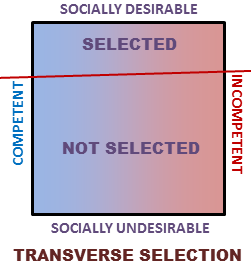 University of Pennsylvania social network researcher Lynn Wu recently discovered a perfect example of transverse selection.
University of Pennsylvania social network researcher Lynn Wu recently discovered a perfect example of transverse selection.
After analyzing several years of anonymized electronic communications from 8000+ employees of a tech firm, she found that while instrumental communications about practical matters drove productivity, social communications about sports and primate food-sharing rituals—like lunches and coffee breaks—drove retention during lay-offs.
More importantly, she found that these two types of communication were substitutes for each other, meaning that they can’t occupy the same network space at the same time.
In simpler terms: practical thinkers did the mission, but social thinkers kept their jobs when push came to shove.
The study’s abstract, contrasting the information diversity of practical communication and the social value of expressive communication, reads:
I consider two intermediate mechanisms by which an information-rich network is theorized to improve work performance — information diversity and social communication — and quantify their effects on productivity and job security. Analysis shows that productivity, as measured by billable revenue, is more associated with information diversity than with social communication. However, the opposite is true for job security. Social communication is more correlated with reduced layoff risks than is information diversity. This, in turn, suggests that information-rich networks enabled through the use of social media can drive both work performance and job security, but that there is a tradeoff between engaging in social communication and gathering diverse information.
It is important to clearly understand that concluding sentence. Wu states that social media can drive both forms of communication, but that there is a zero-sum dynamic between the two, known as a tradeoff or “substitution” relationship.
The common excuse that “these two things aren’t mutually exclusive” does not apply here.
For strategic thinkers, these findings are troubling because they describe a dynamic in which less effective professionals accumulate during reiterated retention and hiring cycles, slowly smothering the practical network of the organization with a cancerous social network of buddy-promoters.
Although, technically, the social communications Wu measured do not themselves qualify as phaticized work, because they are openly social and not disguised as work, the retention they drive is a perfect example of a corrupt and phaticized process.
Each person thus preferentially retained by virtue of social ties represents an in-house embezzlement of every resource the organization thereafter assigns to them because, regardless of the work they do, their position and its attendant resources properly should have gone to someone else. The organization may have allocated the resources anyway, but not to the individual retained for having the right friends.
This is an illicit channeling of value that should be recognized, condemned, and corrected as the corruption it is. And, when its reiteration leads to a smothering accumulation of phatic processes, it should be diagnosed as a severe danger to the future of the organization.

Phaticized work : Gladhanding |
October 30, 2014 at 8:54 pm
[…] gladhanding is not innocent workplace socializing or valuable networking. Such pro-social behavior has been shown to drive productivity out of an organization. And, by exploiting social instincts and personal ties to gain access to organizational resources, […]